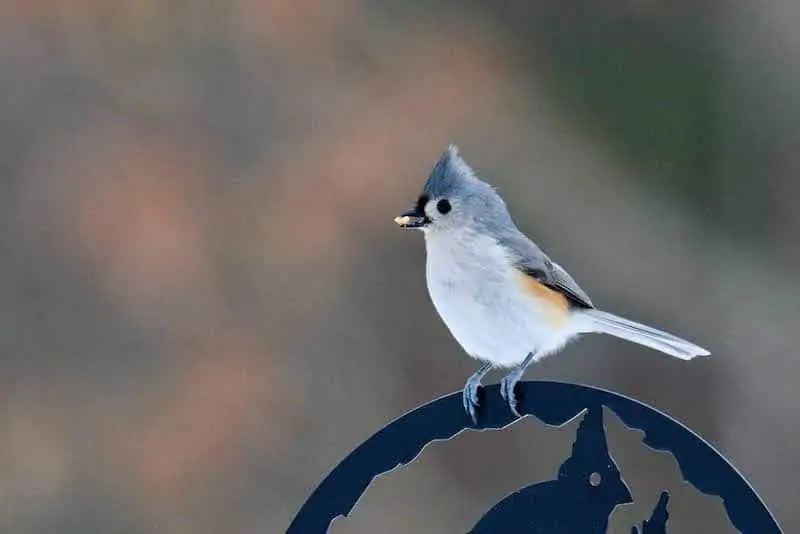Pennsylvania is home to a wide variety of bird species. Some of these species are migratory and only spend the summer or winter in Pennsylvania, while others live there all year. We’ll look at the 26 most frequent backyard birds in Pennsylvania and learn a little about each species in this article.
I’ll then demonstrate how to attract them to your yard, give you a crash course in the 10 distinct types of bird feeders that may be utilized, and even recommend a few birdwatching hotspots in Pennsylvania.
How many different species of wild birds are in Pennsylvania?
It’s tough to tell exactly how many bird species live in North America, the United States, or even Pennsylvania. Pennsylvania, on the other hand, is home to at least 435 different species of birds, according to Wikipedia. There are 2,059 species in North America, according to one source, but just 914 according to another. These numbers provide us with a broad idea of the number of species, but I’m not sure how much I trust them.
We’re going to look at some of the species that most people see in Pennsylvania, particularly in backyards, for the purposes of this article.
26 COMMON BACKYARD BIRDS IN PENNSYLVANIA
In Pennsylvania, we’ll take a look at 26 different kinds of backyard birds, including some migrants. While they aren’t all of the species found in Pennsylvania, they are some of the most well-known backyard birds. Without further ado, let us look at it now!
1. NORTHERN CARDINAL

Scientific name: Cardinalis cardinalis
Length: 8.3-9.1 in
Weight: 1.5-1.7 oz
Wingspan: 9.8-12.2 in
In North America, Northern Cardinals are one of the most well-known and widely seen backyard birds. Females have duller colors and are more tawny brown with some reddish coloring, while males have bright red feathers and a black mask. The crests, which resemble mohawks on top of their heads and reddish orange beaks, are easily recognized by both males and females.
Throughout the year, Northern Cardinals may be found all across Pennsylvania.
Cardinals will come to most seed feeders and offer them a range of seed blends and black sunflower seeds.
2. TUFTED TITMOUSE

Scientific name: Baeolophus bicolor
Length: 5.5-6.3 in
Weight: 0.6-0.9 oz
Wingspan: 7.9-10.2 in
In their range, these small birds are frequently seen at feeders and in backyards. Like Cardinals, they have a little mohawk that distinguishes them from other birds. Titmice have a black patch just above their beaks and are silver-gray on top and lighter on the bottom. On their side beneath the wing, they may sometimes be seen with an orange patch.
All year, Pennsylvania is home to the Tufted Titmouse.
Most seed feeders will be visited by titmice, who will offer black sunflower seeds and mixed seed blends.
3. CHICKADEES
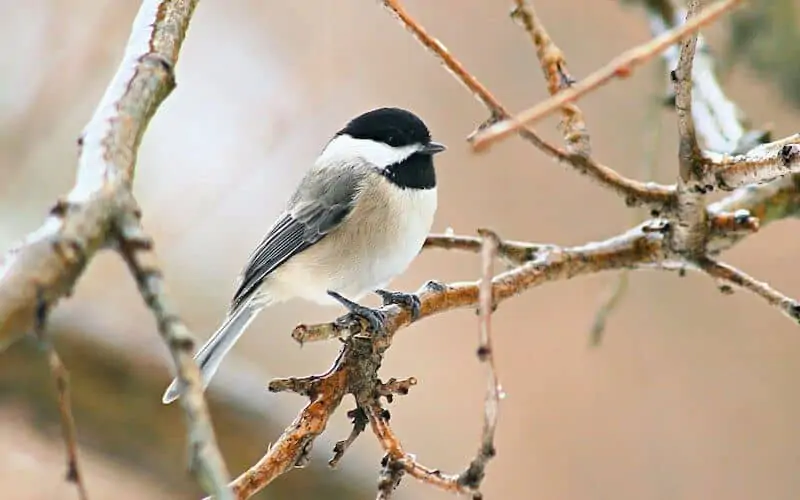
Scientific name: Poecile atricapillus (Black-Capped), Poecile carolinensis (Carolina)
Length: 4.7-5.9 in (Black-Capped), 3.9-4.7 in (Carolina)
Weight: 0.3-0.5 oz (Black-Capped), 0.3-0.4 oz (Carolina)
Wingspan: 6.3-8.3 in (Black-Capped), 5.9-7.9 in (Carolina)
Because of their black cap and black bib, chickadees are little birds that are very easy to identify. Their underbodies are fluffy and light, with white cheeks and gray wings and backs. Around human-provided birdfeeders, they are quick and inquisitive birds that may seem brave.
Black-capped Chickadees and Carolina Chickadees, both of which occur in the east, are close cousins that appear very similar. Depending on the state you’re in, you may be able to tell which is which in many areas. Both chickadees, on the other hand, may be found in Pennsylvania.
All year, both species are in a state of readiness. The southern half of the state is more likely to spot Carolina chickadees. The whole state is home to black-capped chickadees, however the far southeast section may be less well-off.
Most seed feeders will be visited by chickadees, who will provide them a mixture of black sunflower seeds.
4. BLUE JAY
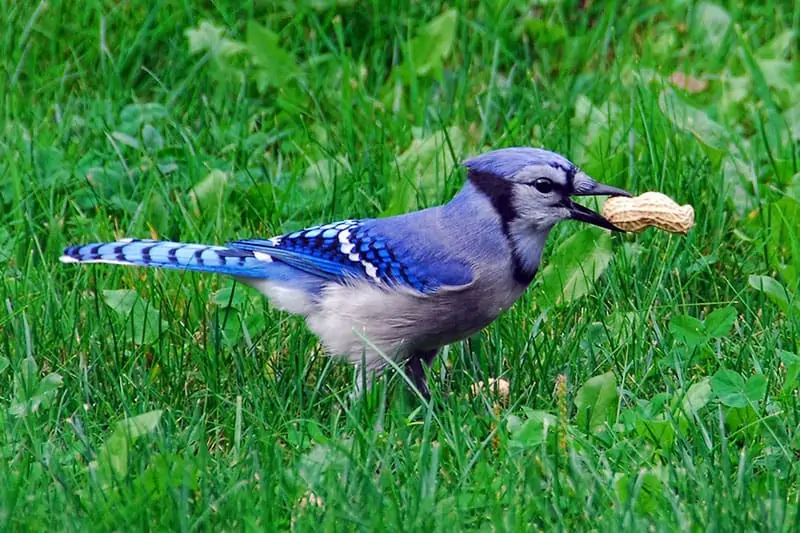
Scientific name: Cyanocitta cristata
Length: 9.8-11.8 in
Weight: 2.5-3.5 oz
Wingspan: 13.4-16.9 in
In North America and the United States, another well-known bird species is the barn swallow. The Blue Jay is the one who appears to be in charge. They have a huge blue crest that is topped with mostly white feathers, with a little blue on the bottom. They have a necklace-like black ring around their necks. White, blue, and black are the colors of their barred wings. The same coloration is seen in both sexes.
Another year-round resident of the entire state of Pennsylvania is the Blue Jays. In backyards and feeders, they’re common.
Platform feeders, peanut feeders, and large perch feeders are all popular with Blue Jays. Give them black sunflower seeds, peanuts, and a variety of seed.
5. EASTERN BLUEBIRD

Scientific name: Sialia sialis
Length: 6.3-8.3 in
Weight: 1.0-1.1 oz
Wingspan: 9.8-12.6 in
Bluebirds have rust-colored reddish-orange bellies and are blue on top. They are named for their color. The colors of girls and boys are identical, however the girls’ blues appear considerably duller and more faded. In the United States, they are perhaps the most sought-after birdhouse tenants. The bluebird house business is booming, to say the least. Although not as much as feeders, they are quite frequent in backyards. I was able to attract a mating pair with this birdhouse, which I put up on Amazon.
Bluebirds migrate in parts of North America, but not in Pennsylvania. Year-round, the Eastern Bluebird may be seen here. To learn more, visit the Bluebird Society of Pennsylvania.
Bluebirds are rarely seed eaters, but may be tempted to sample mealworms on a tray feeder or in a dish.
6. WHITE-BREASTED NUTHATCH

Scientific name: Sitta carolinensis
Length: 5.1-5.5 in
Weight: 0.6-1.1 oz
Wingspan: 7.9-10.6 in
In most backyards within their range, White-breasted Nuthatches are a common feeder bird. Nut-stuffed nuts and seeds beneath tree bark, then with their keen beaks, nuthatches are named after the process of hatching them back out. These birds are better than most other species at climbing vertically on trees. With white on each side and on their bellies, White-breasted Nuthatches have a thick black stripe running across the top of their heads. They have a chisel-like beak that is longer than many other feeder birds, and their wings are mostly gray and black.
Throughout the year, White-breasted Nuthatches can be found in Pennsylvania.
Most seed feeders will be visited by nuthatches, who will provide them with mixed seed mixes, black sunflower seeds, or peanuts. They also like suet and are skilled at holding on to it.
7. AMERICAN ROBIN

Scientific name: Turdus migratorius
Length: 7.9-11.0 in
Weight: 2.7-3.0 oz
Wingspan: 12.2-15.8 in
Robins are most often seen hopping around the grass in search of worms and other invertebrates, and they are rather common in backyards. During the winter, they often retreat to the woods, and in the spring, they seem to have migrated out of the state by returning to more public places. They don’t normally eat seeds, although they’ll sometimes stop by bird feeders. They’re easy to identify because of their bright orange spherical bellies, yellow beaks, and increased size.
In Pennsylvania, robins are found all year.
Attract them to seed feeders with meal worms, native fruit-bearing plants, or a bird bath since American Robins do not often visit them.
8. MOURNING DOVE
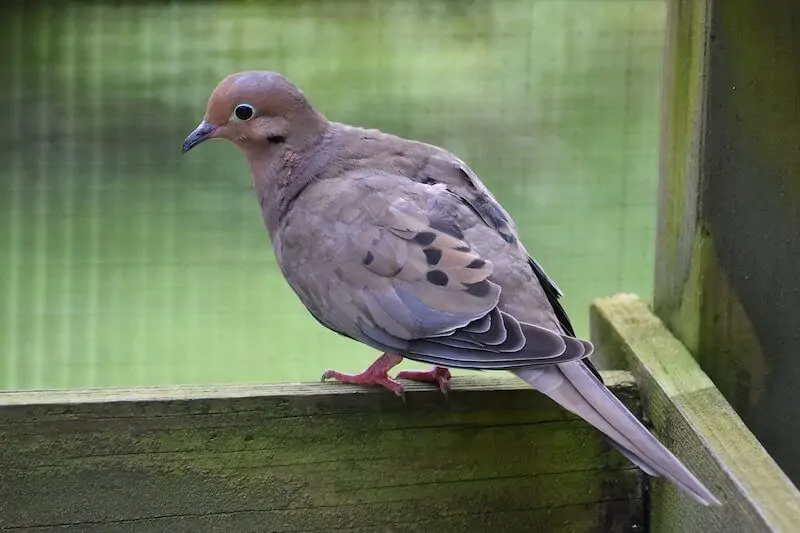
Scientific name: Zenaida macroura
Length: 9.1-13.4 in
Weight: 3.0-6.0 oz
Wingspan: 17.7 in
Doves are small birds that may frequently be seen perched on telephone lines or in clusters in trees. They are about the size of a robin. They’re usually spotted wandering around on the ground underneath hanging bird feeders, but I’ve seen them on my tray feeder on occasion. Mourning Doves have pink legs and are mostly gray with black marks on the top. Both men and women have the same appearance.
Throughout Pennsylvania, Mourning Doves stay throughout the year.
Doves are fond of visiting seed feeders, but they prefer to search for fallen seeds on the ground. Try scattering some seeds on the ground or using a ground feeder with a mixed seed blend.
9. EUROPEAN STARLING
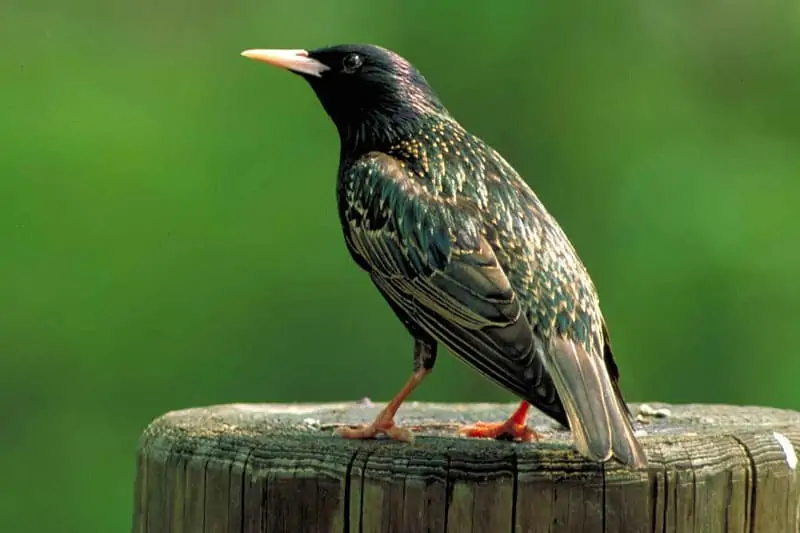
Scientific name: Sturnus vulgaris
Length: 7.9-9.1 in
Weight: 2.1-3.4 oz
Wingspan: 12.2-15.8 in
In the 1890s, 100 starlings were released in New York, and they have since dominated the United States. They will overrun feeders and devour the eggs of other birds, destroying their nests and murdering their offspring. They have yellow beaks and feet and are generally all dark with white flecks on their backs and wings. In the right light, starlings may also be a purple and green iridescent color that is quite lovely.
Every state in the lower 48, including Pennsylvania, has starlings year-round.
Almost anything can be eaten by European Starlings. We recommend that you do not try to attract them since they are an invasive species and will anyway come.
10. AMERICAN GOLDFINCH
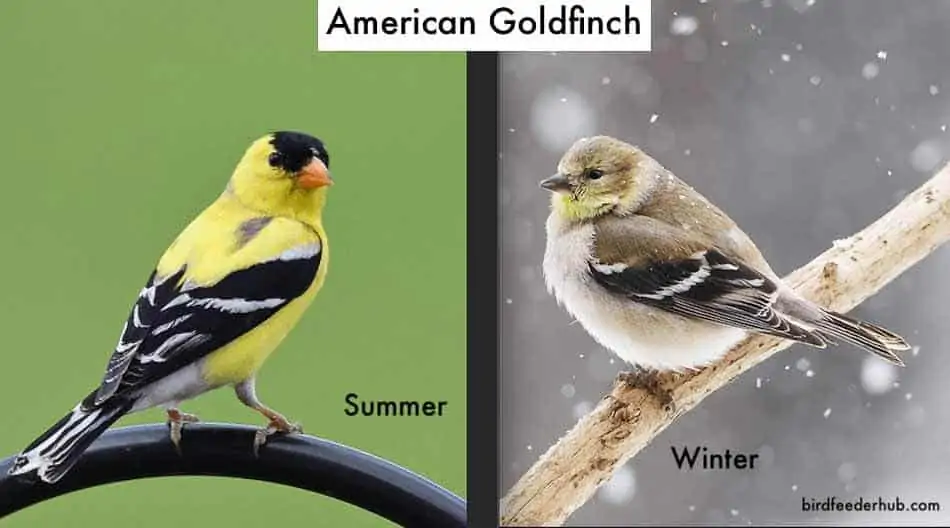
Scientific name: Spinus tristis
Length: 4.3-5.1 in
Weight: 0.4-0.7 oz
Wingspan: 7.5-8.7 in
When the bright yellow feathers of goldfinches are in the spring and summer, they are among my favorite birds to see at feeders. They have black-tipped wings during this time and are mostly yellow, or “gold.” Males also wear a black hat on their heads. They’ll molt during the winter, and their bright colors will fade away, leaving them with a more olive or brown hue. In the winter, they are frequently mistaken with a different species due to their distinct appearance. Their black wings with white bars and finch-like beaks are always identifiable no matter what time of year it is.
Throughout Pennsylvania, goldfinches may be seen all year.
Thistle (nyjer) feeders are preferred by goldfinches. Sunflower chips are another option, but attracting them with a thistle feeder is your best bet.
11. HOUSE FINCH

Scientific name: Haemorhous mexicanus
Length: 5.1-5.5 in
Weight: 0.6-0.9 oz
Wingspan: 7.9-9.8 in
In Pennsylvania, the House Finch is a frequent backyard bird. They are not as widely despised as House Sparrows, and they do not cause the issues that Sparrows do, despite being invasive in the east. They may appear in huge flocks and attack your feeders if you attract them, which is rather simple. Brown with heavy white streaking, both sexes are brown. The top of the head, the chest, and the back of males are splashed with red.
At any time of year, House Finches may be found all throughout Pennsylvania.
Black sunflower or mixed seed is preferred by House Finches, who adore bird feeders. House Finches, like other finches, eat thistle seeds.
12. HOUSE SPARROW

Scientific name: Passer domesticus
Length: 5.9-6.7 in
Weight: 0.9-1.1 oz
Wingspan: 7.5-9.8 in
The only other wild bird species in the United States is House Sparrows, which are frequently viewed as pests. In addition to legal starlings, you may humanely cage and kill them. They, like starlings, were first brought to New York in the 1800s and have since spread across the United States as an invasive species. Their wings and buffy chest are streaked with black and brown, and they are mostly brown in hue. With a black mask and chest, males often stand out. They are more inclined to be aggressive towards other birds, particularly around nests and birdhouses.
Throughout the year, all regions of Pennsylvania are home to House Sparrows.
House Sparrows, like the European Starling, are invasive and endanger native species. Most seed types are acceptable to them.
13. RED-WINGED BLACKBIRD

Scientific name: Agelaius phoeniceus
Length: 6.7-9.1 in
Weight: 1.1-2.7 oz
Wingspan: 12.2-15.8 in
Male Red-winged Blackbirds are one of the most common birds in North America, with their crimson and yellow “shoulders” distinguishing them from the rest of the flock. However, the females of this species are brown with light streaks and look quite different. Males of this species may have up to 15 different females that they are mating with, which makes them polygynous. They like bird feeders and frequently appear in large numbers, despite the fact that they are most comfortable near marshes and wetlands.
The year-round residents of Pennsylvania are Red-winged Blackbirds.
Most types of feeders are visited by Red-winged Blackbirds, who will eat both seed and suet.
14. BROWN-HEADED COWBIRD
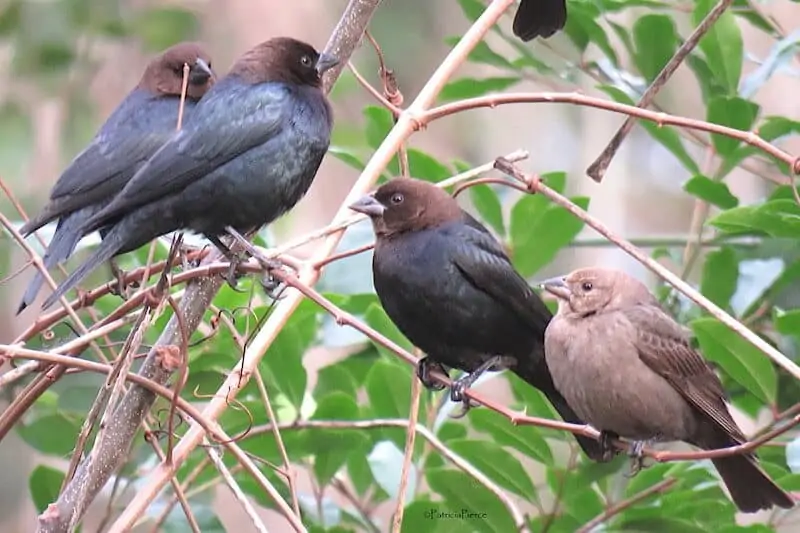
Scientific name: Molothrus ater
Length: 7.5 – 8.7 in
Weight: 1.5 – 1.8 oz
Wingspan: 12.6 – 15.0 in
Because of the males’ color and the fact that they fly in large flocks (sometimes mixed with actual blackbirds), brown-headed cowbirds are often classified as “blackbirds.” The body of a male is iridescent black, while the head is dark brown. Females have a lighter brown coloration all over.
Cowbirds, on the other hand, are “nest parasites,” and by laying their eggs in the nests of other birds, they harm the balance of nature. They may sneak one egg among the others or kick other eggs out of the nest in order to make room for their own. The imposter egg is often ignored by many birds, and the youngster will be raised as their own.
All year long, Pennsylvania is home to the Cowbirds.
Feeders are readily visited by brown-headed cowbirds, who may arrive in large numbers. Mixed seed will be eaten by them in virtually every conceivable combination.
15. SONG SPARROW
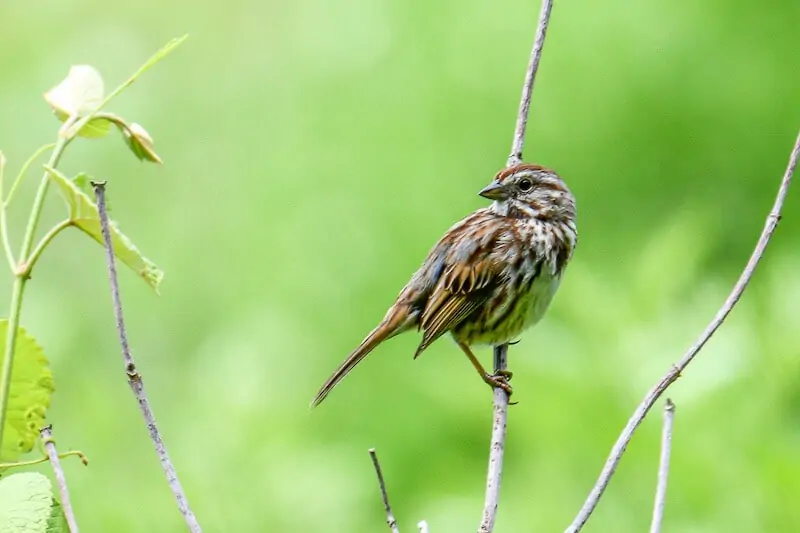
Scientific name: Melospiza melodia
Length: 4.7-6.7 in
Weight: 0.4-1.9 oz
Wingspan: 7.1-9.4 in
The plumage of song Sparrows varies depending on where they are found in North America. These sparrows have a brown back and wings, with deep brown streaks on their breast and a white belly in the east. Their chest stripes frequently merge in a prominent brown patch that can aid with identification. In addition to attracting females, the male of the species uses his song to defend his territory.
Song Sparrows may be found all throughout Pennsylvania throughout the year, though they move
Song Sparrows like to visit bird feeders and eat mixed seeds and sunflower seeds there.
16. RED-BELLIED WOODPECKER
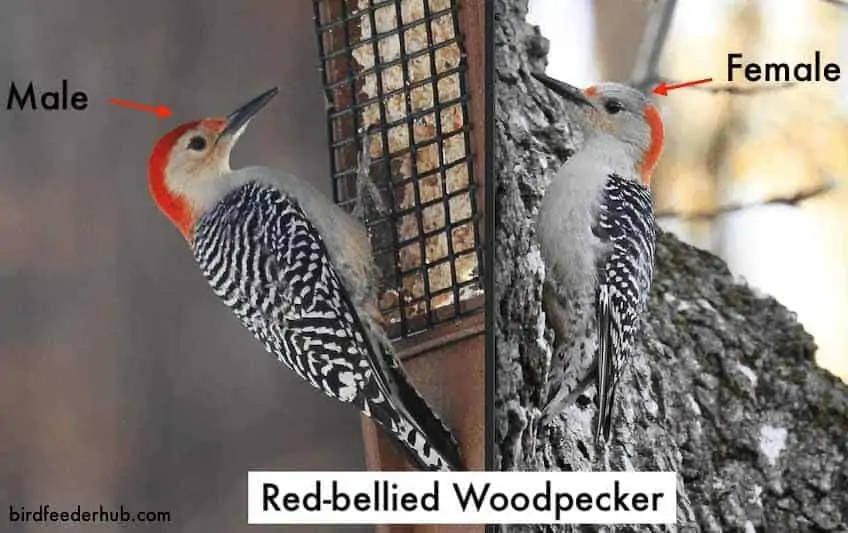
Scientific name: Melanerpes carolinus
Length: 9.4 in
Weight: 2.0-3.2 oz
Wingspan: 13.0-16.5 in
In the eastern United States, these medium-sized woodpeckers are fairly frequent at feeders and yards. The bright red stripe down the back of their heads is the first thing you’ll notice, even though they’re classified as “red-bellied.” They have a white breast that is unmarked, except for a pinkish-red patch in the lower section of their belly. With the white and black barring on their wings, they are really easy to identify.
In Pennsylvania, red-bellied woodpeckers may be found year-round, although in the far northeastern part of the state, they are only present in small numbers.
While they will devour seed feeders, particularly if you provide mixes with peanuts, attract Red-bellied Woodpeckers with a suet feeder.
17. DOWNY WOODPECKER

Scientific name: Picoides pubescens
Length: 5.5-6.7 in
Weight: 0.7-1.0 oz
Wingspan: 9.8-11.8 in
The common backyard birds, the downy’s, love to visit bird feeders. They are one of the first species I see at a new bird feeder, and they are the smallest woodpeckers in North America. Their totally white underbodies, black wings with white dots, black and white striped heads, and a crimson spot on the back of their heads (males have no red) make them easy to identify. Downy’s are smaller with shorter beaks and closely resemble the Hairy Woodpecker.
Throughout the whole state of Pennsylvania, you may spot Downy Woodpeckers year-round.
At most types of bird feeders, the Downy Woodpeckers are very common. Mixing seed, black sunflower seed, and suet are all available.
18. CAROLINA WREN
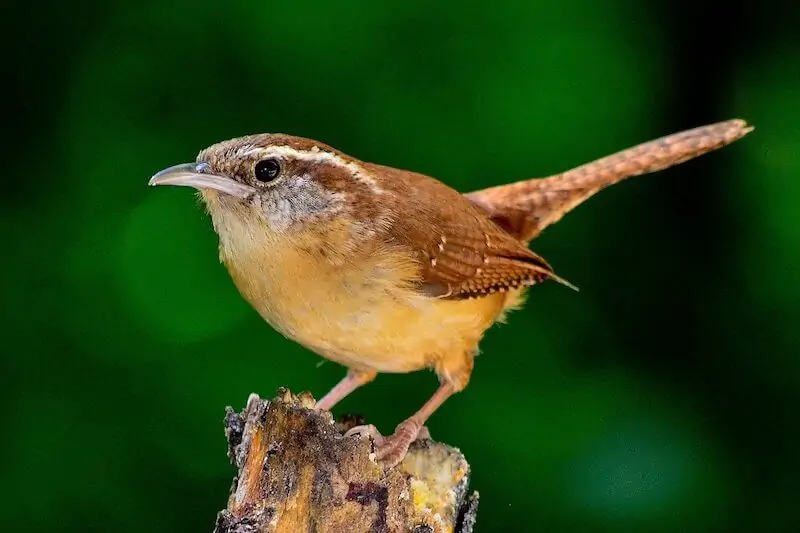
Scientific name: Thryothorus ludovicianus
Length: 4.7-5.5 in
Weight: 0.6-0.8 oz
Wingspan: 11.4 in
The top of these tiny birds is generally reddish-brown, while the bottom is light orangish. Their powerful white “eyebrow,” as well as their longish somewhat bent beak, are highly distinctive. They prefer to lurk in the bushes, making them difficult to observe. Nevertheless, their loud “teakettle-teakettle” call is unmistakable.
Throughout the year, Carolina Wrens can be found across Pennsylvania.
In backyards, Carolina Wrens are often seen visiting suet feeders and are quite common.
19. INDIGO BUNTING

Scientific name: Passerina cyanea
Length: 4.7-5.1 in
Weight: 0.4-0.6 oz
Wingspan: 7.5-8.7 in
These stunning buntings head up from their wintering areas in Mexico and southern Florida at night, migrating north. Males are bright blue all over with black on their wings, while females are predominantly brown with just hints of blue. Rather than blue pigment, these feathers reflect light in a different way. Look for them in the summer, singing among the fields and woods’ edges.
Throughout the spring and summer, Indigo Buntings may be found all over Pennsylvania.
They will occasionally visit, albeit not as frequently as feeders, if you offer mixed seed and nyjer.
20. DARK-EYED JUNCO
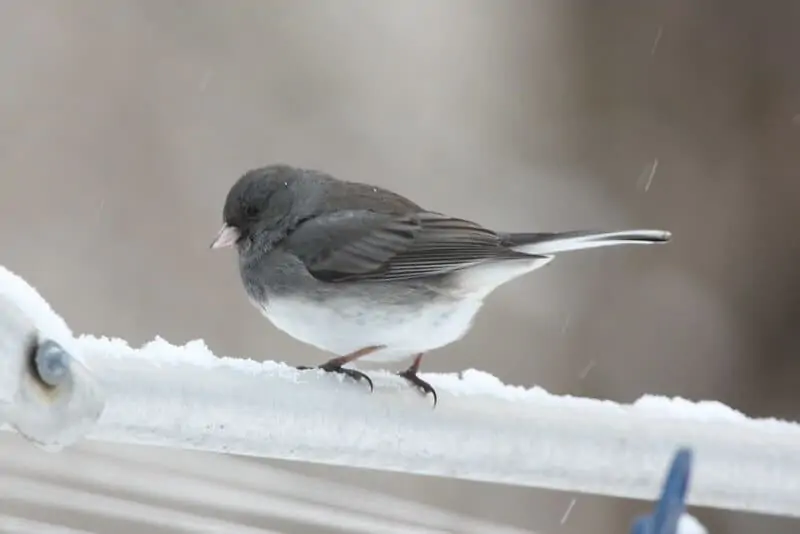
Scientific name: Junco hyemalis
Length: 5.5-6.3 in
Weight: 0.6-1.1 oz
Wingspan: 7.1-9.8 in
Because Juncos spend their summers in Canada, many people in the United States consider them winter birds. Across the United States, they come in a variety of colors. In the eastern United States, Slate-colored variants are widely available.
The head, chest, back, wings, and tail are all dark gray. They have a white belly that extends all the way to the end of their tail. Females may appear buffy brown rather than gray and may look similar. The light pink beak and spherical body form of junco are excellent characteristics to look for when identifying them. These can be found hopping around on the ground in forests and wooded regions, where they are most prevalent.
Throughout the year, dark-eyed Juncos may be found in a variety of locations in Pennsylvania, but particularly during the winter.
Juncos will visit feeders on occasion, but they prefer to eat ground seed beneath your feeders rather than seeds that other birds drop. Mixed seeds are a big hit with them.
21. CHIPPING SPARROW
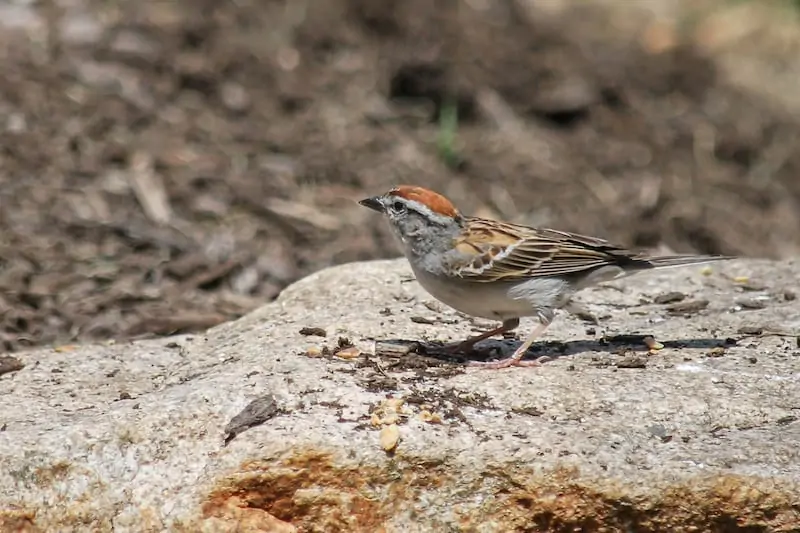
Scientific name: Spizella passerina
Length: 4.7-5.9 in
Weight: 0.4-0.6 oz
Wingspan: 8.3 in
Chipping sparrows migrate south for the winter after spending their breeding season in the northern part of North America. With a buffy gray breast, brown and tan streaked wings, rusty red head, and a black line through the eye with white above, they have their most crisp feathers in the summer. Their markings may fade in definition and their color become more buffy-brown in the winter. Sparrows that like to feed on open ground are common.
Only during the spring and summer are Chipping Sparrows seen across Pennsylvania.
Backyard feeders are home to Chipping Sparrows, who like to pick through what has fallen on the ground. Sunflower and mixed seed, especially scattered on the ground, are effective at attracting them.
22. RUBY-THROATED HUMMINGBIRD
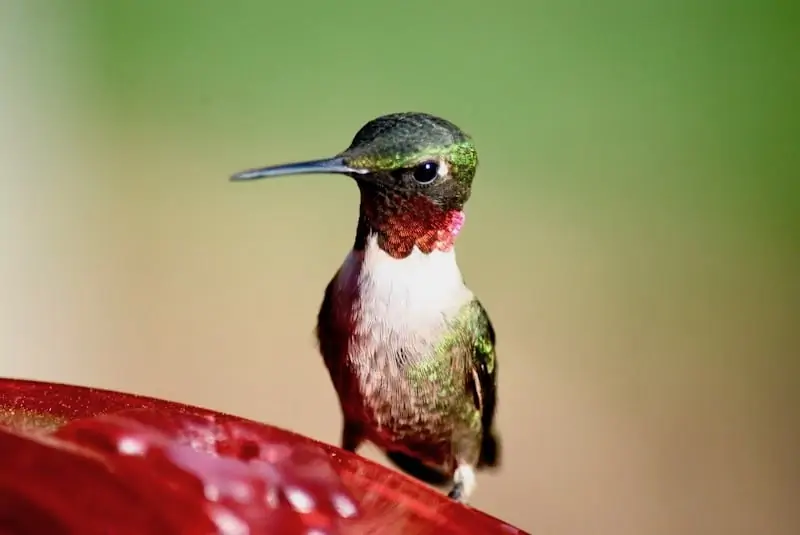
Scientific name: Archilochus colubris
Length: 2.8-3.5 in
Weight: 0.1-0.2 oz
Wingspan: 3.1-4.3 in
Ruby-throated Hummingbirds are the most common type of hummingbird in the United States, although they are only seen in the east. In the Eastern United States, they are also the only hummingbird breeding species. Males have a vivid crimson neck, therefore they are called Ruby-Rumped Trochilidae. With white under-parts, Ruby-throated Hummers are emerald green on the back, wings, and heads. The red throat feathers are lacking in females.
Ruby-throated Hummingbirds are the most common hummingbirds in Pennsylvania, and you may sometimes encounter a few uncommon wandering varieties. From spring to fall, they can be found all throughout the state.
If you put out nectar feeders, Ruby-throated Hummingbirds are very likely to be seen in gardens in April or May.
23. EASTERN TOWHEE

Scientific name: Pipilo erythrophthalmus
Length: 6.8-8.2 in
Weight: 1.1-1.8 oz
Wingspan: 7.9-11.0 in
A delightful species of backyard bird, the Eastern Towhee is always a delight to observe. With white wing spots, orange sides, and a white belly, both sexes have a dark head and back. Nonetheless, males have a black complexion whereas women have a brown complexion. In the woods during spring and summer, they have a lovely song that has a familiar sound. Towhees look for insects, seeds, and berries among the leaf litter and vegetation of master foragers. Leave some brushy borders and leaf litter along your yard line to increase the likelihood of attracting towhees to your property.
During the breeding season (spring and summer), Eastern Towhees move to Pennsylvania, then in the fall they migrate south.
In my observation, eastern Towhees seldom eat from bird feeders on a regular basis, yet I regularly see them hopping around the ground beneath my feeders. In that sense, bird feeders may be used to attract towhees.
24. GRAY CATBIRD

Scientific name: Dumetella carolinensis
Length: 8.3-9.4 in
Weight: 0.8-2.0 oz
Wingspan: 8.7-11.8 in
Catbirds are robin-sized birds with a black head and a long tail who have dark slate gray coloring all over. A reddish patch appears beneath their tails, but it is seldom visible. Native fruit-bearing trees and shrubs appeal to catbirds, who adore to eat fruits. Their calls, which sound like those of a meowing cat, led to the moniker catbird.
Only during the spring and summer do Gray Catbirds may be found in Pennsylvania and most of the United States.
If you provide some sweets, berries, and other sweet foods, you may be able to attract catbirds if they prefer to forage on the ground or in shrubs for food.
25. NORTHERN FLICKER

Scientific name: Colaptes auratus
Length: 11.0-12.2 in
Weight: 3.9-5.6 oz
Wingspan: 16.5-20.1 in
In the United States, these medium to big woodpeckers are fairly prevalent in backyards, but not as common at feeders. They’re also one of the most vibrant birds in North America, in my opinion. Flickers, unlike other woodpeckers, prefer to hunt for insects on the ground rather than in trees. Their bellies have black spots, their bib is solid black, the back of their necks has a red patch, and their wings are barred black and gray. The mustache of males is black. The yellow-shafted variety, which has brilliant yellow feathers on the bottom of its wings and tail, may be found in Pennsylvania.
Throughout Pennsylvania, Northern Flickers can be found year-round.
Despite their frequent absence from feeders, Northern Flickers will still visit suet feeders. You may observe them digging around for insects if you have some leaf piles in your yard.
26. WHITE-THROATED SPARROW

Scientific name: Zonotrichia albicollis
Length: 6.3-7.1 in
Weight: 0.8-1.1 oz
Wingspan: 7.9-9.1 in
The White-throated Sparrow is a ubiquitous bird across the United States. They migrate to Canada in the summer to breed during the winter. Their bold facial pattern of black and white stripe with yellow spots between the eyes, as well as their white throat patch, make them easier to identify among sparrows. Females prefer to nest in secret places in thick shrub and vegetation, often on or just above the ground.
The White-throated Sparrow is most often found throughout the United States. They migrate to Canada to breed throughout the summer after spending the winter in Canada. Their bold facial pattern of black and white stripes with yellow dots between the eyes makes them easier to identify among sparrows. Their white throat patch also helps. Females often build nests in concealed parts of thick shrub and vegetation, sometimes on or just above the ground.
During the winter months, white-throated sparrows can be found across Pennsylvania. Others may hang here all year along the state’s northern border.
Feeders are visited frequently by white-throated sparrows, who like to collect fallen seed on the ground below feeders. Sunflower, millet, and mixed seed blends are available.
HOW TO ATTRACT BIRDS TO YOUR YARD
Want to attract some of these birds to your yard? Take a look at these five basic steps, starting with the most obvious.
1. PUT OUT BIRD FEEDERS
Placing a bird feeder or two out in your yard is the finest and most evident strategy to attract birds. A basic tube feeder, hopper feeder, platform feeder, or window feeder is a good place to start. For each, there are some recommendations listed below.
2. ADD A WATER SOURCE
You may use a terra cotta flower pot saucer, like this one, instead of a pedestal birdbath. Birds need water not only to wash in, but also to consume, so adding a water feature to your property will simply raise your chance of attracting them. Since moving water will attract the birds even more, consider adding a solar fountain.
3. OFFER BIRDHOUSES
If placed in the proper location at the proper time of year, many kinds of birds will readily take up residence in birdhouses. Among the most popular birds to attract to birdhouses are Eastern Bluebirds. A mating pair of bluebirds checked out my birdhouse the same day I put it, and I have it in my yard.
4. PROVIDE SHELTER
Make sure there are trees, shrubs, and plants in your yard that the birds can fly to when they sense danger. Predators are prevented from attacking them in this way. Try to add some landscaping characteristics that will enable birds to see your yard as safe if your yard is in a new development with no mature trees.
5. ADD NATIVE PLANTS
Having native plants that produce nuts, berries, and seeds will merely help your efforts to attract more birds for many birds that eat them. Moreover, since most songbirds feed insects to their hatchlings, native plants aid caterpillars and other insect-eating creatures that help many birds and support nesting birds. Native flora that support a healthy ecosystem should be avoided, especially invasive and non-native flora.
10 DIFFERENT TYPES OF BIRD FEEDERS
The most popular bird feeders in the yards of 10 people are shown below.
- Hopper feeders are called that because they feature a hopper in the centre, which holds the bird seed. Birds may land on and eat from the perches on each side. To keep the seed dry, many hopper feeders are shaped like a house and roofed. For this kind of feeder, use black sunflower seeds or a combination of birdseed. This is a squirrel-proof hopper feeder, which I adore.
- Platform feeders are open on top and may be hung from a tree, hook, or pole-mounted. They are sometimes referred to as tray feeders. They’re simple to put up and are ideal for feeding most sorts of birds. Every animal in your yard that can reach them will eat from them, despite the fact that they are completely open. For this kind of feeder, try using black sunflower seeds or mixed birdseed. In the moment, I’m using a platform feeder in my yard.
- Tube feeders are simply clear plastic tube-shaped bird feeders, and they’re the most basic kind. They may hold from a few cups of seed to 5 pounds or more, and they may vary in size. These are fantastic since they allow you to replenish your seed whenever it runs out while keeping it fresh and dry. Tube feeders are used by a variety of birds. Tube feeders can be used with black sunflower seeds and mixed seeds. This squirrel proof tube feeder is made by Squirrel Buster and is one of their best products.
- Suet feeders are used to feed suet cakes to a single kind of bird. They are a very basic design, frequently constructed of a metal wire cage with a tail-prop for bigger birds. During the winter, when birds are seeking high-fat foods, suet feeders are very popular, and woodpeckers frequently visit them. I recommend the Pileated and Northern Flicker, as well as other larger woodpeckers, use a suet feeder with a long tail prop.
- Small bird feeders that use suction cups to mount onto a glass window are known as window feeders. They’re open on top and you just pour seed into the tray area to replenish them, similar to tray feeders. Many different kinds of birds appreciate these feeders, they’re simple to set up, and they’re ideal for people with small yards who don’t have a lot of space. For this kind of feeder, use dark sunflower seeds or a combination of birdseed. This is, without a doubt, the most popular bird feeder on Amazon, and maybe the most popular window feeder.
- Thistle feeders, sometimes known as Nyjer feeders, are designed specifically for thistle seedbirdfeeders. Birds in the finch family, which includes the American Goldfinch and House Finch, are the primary species of birds that thistle feeders attract. Thistle feeders are often circular in shape and have tiny holes along the circumference of the circle that enable birds to pick thistle from them. Droll Yankees has a fantastic thistle feeder.
- Ground feeders are tray feeders that sit on the ground rather than on a higher level. Birds like Mourning Doves, Juncos, and squirrels will love them, as will raccoons and other ground creatures. For this feeder, use black sunflower seeds or a combination of birdseed. This recycled plastic ground feeder is a good option for you.
- Another kind of specialty feeder for just one sort of bird, orioles, is the Oriole feeder. Little plastic or glass dishes designed for holding jelly, which orioles adore, are commonly used to feed the feeder itself. Another delicacy that orioles adore is orange halves, which they also allow you to attach to the feeder. Here’s an oriole feeder that holds orange halves with four jelly trays.
- Hummingbird feeders, also known as nectar feeders, are built to extract sugar water from hummingbirds. I often see Downy Woodpeckers at mine, despite the fact that they are meant for hummingbirds, and they also like that sweet nectar. How to make hummingbird nectar without boiling the water may be found in this article. There is no need to spend a lot of money on a hummingbird feeder since they are simple and inexpensive.
- Peanut feeders are tube-shaped and typically made of metal wire mesh material, similar to thistle feeders. To allow for whole unshelled or shelled peanuts to pass through the holes, the holes in the wire mesh are only a few centimeters apart. These should be filled with peanuts and attract birds like Blue Jays. Squirrel Buster’s squirrel deterrent is the best option if you want to keep squirrels out of your peanut feeder. This basic one will suffice.
BIRD WATCHING IN PENNSYLVANIA
If you want to go outside of your own backyard for birding, Pennsylvania is a fantastic state to visit. If you want to get a little more engaged, the Audubon Society of Pennsylvania hosts meetups, seminars, field excursions, and birding trips on a regular basis.
Take a look at this list I’ve put together of some popular birding sites in Pennsylvania if you’re a Pennsylvania resident and want to add some new species to your life list.
PENNSYLVANIA BIRDING LOCATIONS
(In addition to local birding events and festivals, learn more about what each of these places has to offer.)
- Bald Eagle State Park
- Erie National Wildlife Sanctuary
- Hawk Mountain
- John Heinz National Wildlife Refuge at Tinicum
- Presque Isle State Park
Audubon’s Pennsylvania Important Bird Areas can help you find even more hotspots.
